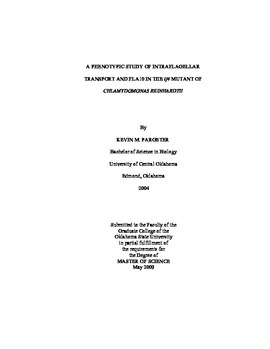| dc.description.abstract | Chlamydomonas reinhardtii is a biflagellate, unicellular green alga that serves as an ideal basic science organism (Harris, 2008a). Compared to eukaryotic primary cilia, it shares many homologous flagellar genes with humans, of which several ciliary disorders, or ciliopathies, are known to occur (Pazour, 2008). Almost all vertebrate cells possess primary cilia, but this organelle had long been thought to have no function (Pan et al., 2005). With the discovery of intraflagellar transport (IFT), the mechanism for flagellar assembly, by Kozminski and coworkers (1993), new approaches to study ciliopathies were established. To investigate how flagellar length was controlled, long-flagellar mutants lf1, lf2, lf3 and lf4 were created. Yet little phenotypically was known about lf4. To characterize the morphology of and localize IFT proteins (FLA10p and LF4p) in the lf4 mutant, this work used bright-field microscopy, immunofluorescence microscopy (IMF), scanning electron microscopy (SEM) and transmission electron microscopy (TEM). The lf4 flagella were grossly longer than wild-type cells, which were observed to be most active at 36 h. The lf4 cells were most active between 24-36 h likely indicating the best time to harvest for experimentation. Using IMF, the FLA10p and LF4p localized to flagella in a punctate pattern, likely indicating IFT particles. No bulbous tips were observed in lf4, unlike the lf2 and lf3 mutants as reported by Tam and coworkers (2003; 2007). Multiple IFT particles were observed in cross-sectional and longitudinal flagellar ultrastructure of lf4 using TEM. Plus, an as yet unidentified electron-dense structure in an lf4 cross-section was observed to connect the outer doublet microtubules to the cell membrane. Quantification of IFT particles per length, area and volume of flagella were the same in wild-type and lf4, suggesting that IFT particle quantity is independent of length. Immunogold electron localization is the logical next step to further the phenotypic characterization of the lf4 mutant. | |
